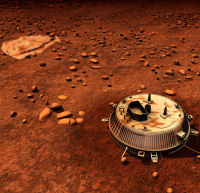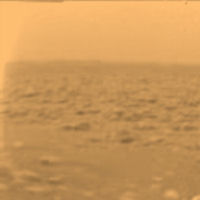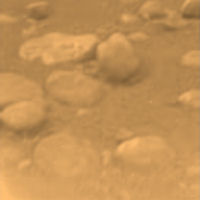The Huygens probe lands on Titan
Probing an alien atmosphere

The instruments onboard Huygens were designed to find out what aerosols, and therefore chemicals, were present in the atmosphere. Previous remote studies of Titan told scientists that its atmosphere was made out of Nitrogen and Methane but the Huygens probe was able to directly investigate what different gases were present. In addition, one instrument made measurements to find out if clouds and lightning occurred.
Landing on unknown terrain
The entire mission was designed to take place during the descent through the atmosphere. It was hoped that scientists would get a few minutes of data once the probe reached the surface, however it was not known if the probe would survive its impact and scientists did not know what kind of terrain it would land on.
Determining the surface of Titan

During the journey through the atmosphere, Huygens' instruments also investigated the surface of this moon. A camera took images and collected light to determine what elements, chemicals or minerals were present on the surface. Another instrument studied the Titan landscape to distinguish - before impact - whether the surface was liquid or solid.
Huygens was the first probe to land on a body in the outer Solar System and the furthest from Earth. On impact with the Titan surface an accelerometer measured how quickly the probe stopped moving. A suite of sensors then started to find out what it was like at the surface, measuring properties such as the temperature and how quickly sound and light waves travelled.
More detailed information about the Huygens probe instruments can be found here.
What was discovered about Titan?
Before the Huygens probe reached Titan scientists believed that the probe would encounter jet streams and currents that circulated the gases in the Titan atmosphere on its journey to the surface. Measurements of these winds were possible by studying how the molecules present in the moon’s atmosphere moved, this was achieved by following the faint infrared light they emit.
As Huygens travelled through Titan’s alien atmosphere it was carried by the wind. Computer modelling of the atmosphere, based on the winds, revealed that it is like a giant conveyor belt circulating the wind from north to south and south to north.
Titan has a hazy thick atmosphere, which Huygens found to be even hazier than expected due to the presence of aerosols or dust particles. Scientists were also surprised to find that the two noble gases, Xenon and Krypton, were not found.
Measurements of the atmosphere confirmed that complex organic compounds, the building blocks of the amino acids necessary for life, were present in both gas and solid phases.
Until the Cassini-Huygens mission little was known about the surface of Titan. Despite atmospheric haze the cameras onboard the Huygens probe were able to take clear images of Titan’s surface. The first images of the surface showed a world that resembled the Earth in many ways with evidence that a liquid, possibly methane, had flowed on the surface causing erosion.
At the landing site of the probe the surface was found to have the consistency of loose wet sand that was mostly made up of dirty water-ice pebbles. The surface material detected gases that had not been found higher up in the Titan atmosphere, including carbon dioxide. The Huygens probe also measured the weather conditions at the surface, detecting light winds, a temperature of -170 degrees Celsius and an atmospheric pressure slightly higher than Earth’s.
More to discover
The Huygens probe made measurements of Titan's atmosphere and surface for just four hours but supplied scientists with enough data to keep them busy for many years. Combining this information with data of Titan taken by the Cassini orbiter as it performs numerous flybys of Saturn’s largest moon scientists will continue to piece together the puzzle of one of the Solar Systems most mysterious moons.


